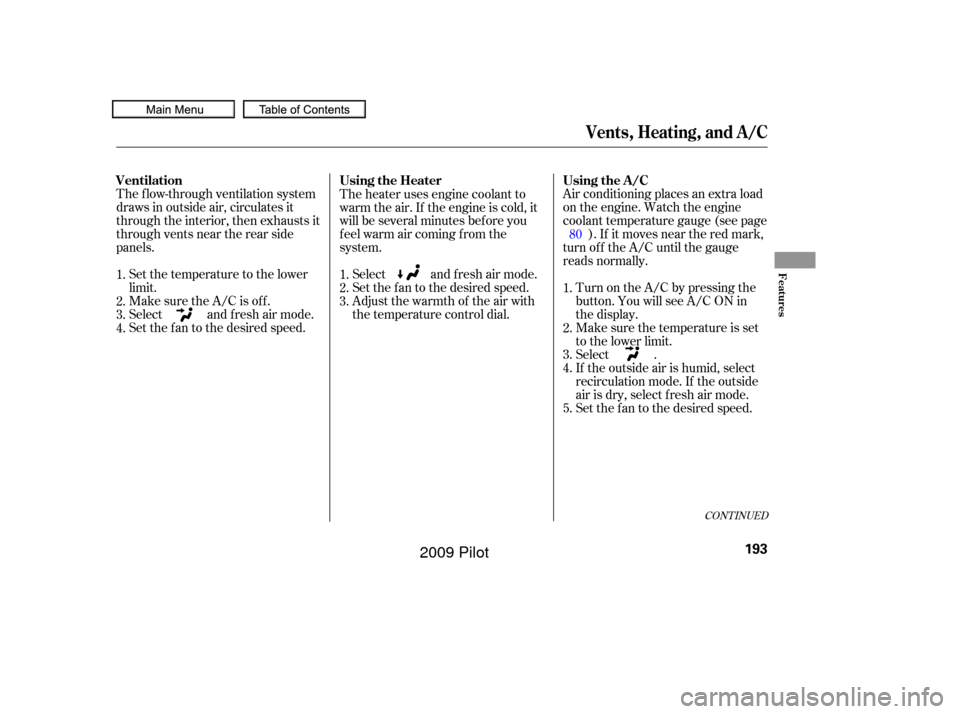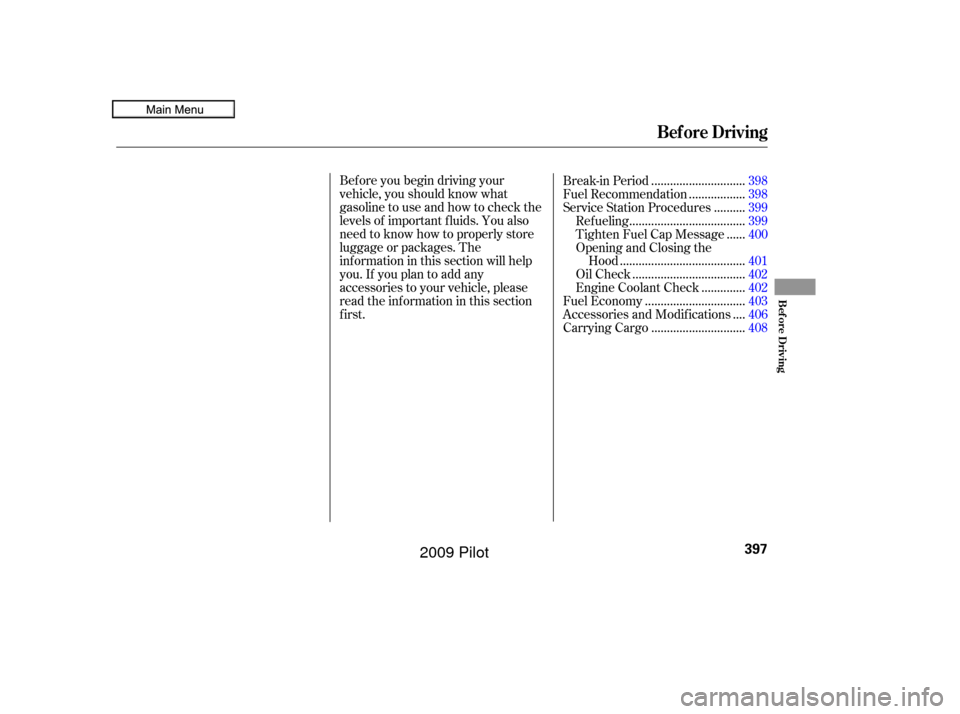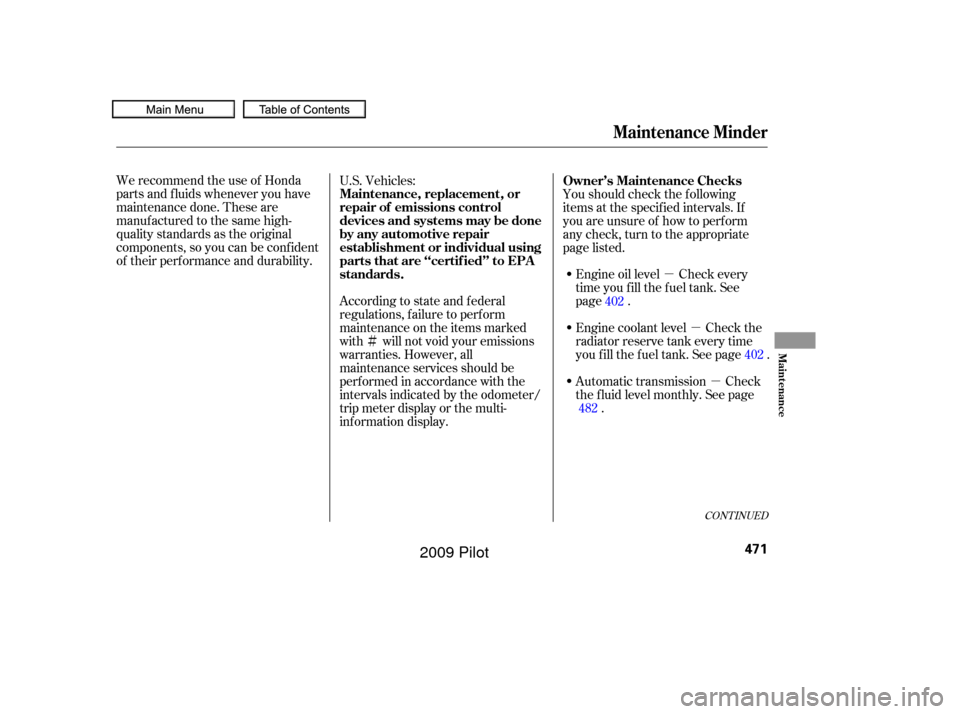Page 84 of 578
This shows the temperature of the
engine’s coolant. During normal
operation, the pointer should rise to
about the middle of the gauge. In
severe driving conditions, the pointer
may rise to the upper zone. If it
reaches the red (hot) mark, pull
safely to the side of the road. For
instructions and precautions on
checking the engine’s cooling
system, see page .
This shows how much f uel you
have. It may show slightly more
or less than the actual amount.523
Gauges
Temperature Gauge
Fuel Gauge
80
U.S. model is shown. SPEEDOMETER
FUEL GAUGE
TEMPERATURE GAUGE
TACHOMETER
INFORMATION DISPLAY
SELECT/RESET KNOB
SPEEDOMETER FUEL GAUGE
TEMPERATURE GAUGE
SELECT/RESET KNOB
Touring models Except Touring models
TACHOMETER MULTI-INFORMATION DISPLAY
Avoid driving with an extremely low
f uel level. Running out of f uel could
cause the engine to misf ire, damaging
the catalytic converter.
�����—�����—�
���y�
�������������y���
�(�/���������y���������y
2009 Pilot
Page 197 of 578

Air conditioning places an extra load
on the engine. Watch the engine
coolant temperature gauge (see page). If it moves near the red mark,
turn of f the A/C until the gauge
reads normally.
The f low-through ventilation system
draws in outside air, circulates it
through the interior, then exhausts it
through vents near the rear side
panels.
The heater uses engine coolant to
warm the air. If the engine is cold, it
will be several minutes bef ore you
f eel warm air coming f rom the
system.
Set the temperature to the lower
limit.
Make sure the A/C is of f .
Select and fresh air mode.
Set the f an to the desired speed. Select and fresh air mode.
Set the f an to the desired speed.
Adjust the warmth of the air with
the temperature control dial.
Turn on the A/C by pressing the
button. You will see A/C ON in
the display.
Make sure the temperature is set
to the lower limit.
Select .
If the outside air is humid, select
recirculation mode. If the outside
air is dry, select f resh air mode.
Set the f an to the desired speed.
1.
2.
3.
4.
5.
1.
2.
3.
1.
2.
3.
4. 80
CONT INUED
Vents, Heating, and A/C
Using the A/C
Ventilation Using the Heater
Features
193
�����—�����—�
���y�
�������������y���
�(�/���������y���
�����y
2009 Pilot
Page 401 of 578

Bef ore you begin driving your
vehicle, you should know what
gasoline to use and how to check the
levels of important f luids. You also
need to know how to properly store
luggage or packages. The
inf ormation in this section will help
you. If you plan to add any
accessories to your vehicle, please
read the information in this section
first..............................
Break-in Period .398
.................
Fuel Recommendation . 398
.........
Service Station Procedures . 399
....................................
Ref ueling .399
.....
Tighten Fuel Cap Message . 400
Opening and Closing the .......................................
Hood .401
...................................
Oil Check .402
.............
Engine Coolant Check . 402
...............................
Fuel Economy .403
...
Accessories and Modif ications . 406
.............................
Carrying Cargo .408
Bef ore Driving
Bef ore Driving
397
�����—�����—�
���y�
�������������y���
�(�/���������y���������y
2009 Pilot
Page 406 of 578
Wait a f ew minutes af ter turning the
engine of f bef ore you check the oil.Remove the dipstick (orange loop). Remove the dipstick again, and
check the level. It should be
between the upper and lower
marks.
If it is near or below the lower mark,
see on page .Look at the coolant level in the
radiator reserve tank. Make sure it is
between the MAX and MIN lines. If
it is below the MIN line, see
on page f or
inf ormation on adding the proper
coolant.
Refer to on page f or inf ormation
about checking other items on your
vehicle.
Wipe of f the dipstick with a clean
cloth or paper towel.
Insert the dipstick all the way back
into its hole.
1.
3. 2.
4.
476 479
471
Oil Check
A dding Engine OilEngine Coolant Check
A dding
Engine Coolant
Owner’s Maintenance
Checks
Service Station Procedures
402
DIPSTICK
UPPER MARK
LOWER MARK RESERVE TANK
MIN MAX
�����—�����—�
���y�
������
������y���
�(�/���������y���������y
2009 Pilot
Page 461 of 578

This section explains why it is
important to keep your vehicle well
maintained and how to f ollow basic
maintenance saf ety precautions.
This section also includes
instructions on how to read the
maintenance minder messages on
the inf ormation display or multi-
inf ormation display (depending on
models), and instructions f or simple
maintenance tasks you may want to
take care of yourself .
If you have the skills and tools to
perf orm more complex maintenance
tasks on your vehicle, you may want
to purchase the service manual. See
page f or inf ormation on how to
obtain a copy, or see your dealer.......................
Maintenance Saf ety .458
....................
Maintenance Minder . 459
..............................
Fluid Locations .474
......
Engine Compartment Covers . 475
........................
Adding Engine Oil .476
Changing the Engine Oil and ...........................................
Filter .477
..............................
Engine Coolant .479
....................
Windshield Washers .481
....
Automatic Transmission Fluid . 482
.................
Rear Dif f erential Fluid . 484
.............
Transf er Assembly Fluid . 484
....................................
Brake Fluid .485
....................
Power Steering Fluid . 486
....................................
Timing Belt .486
.............................................
Lights .487
..................
Dust and Pollen Filter . 494
................
Cleaning the Seat Belts . 494
.....................................
Floor Mats .495
.................................
Wiper Blades .496
...............................................
Tires .500
...................
Checking the Battery . 508
.............................
Vehicle Storage .510
469
Maintenance
Maint enance
457
�����—�����—�
���y�
�������������y���
�(�/���������y���������y
2009 Pilot
Page 475 of 578

�Ì�µ
�µ�µ
We recommend the use of Honda
parts and f luids whenever you have
maintenance done. These are
manuf actured to the same high-
quality standards as the original
components, so you can be conf ident
of their perf ormance and durability.
U.S. Vehicles:
According to state and federal
regulations, f ailure to perf orm
maintenance on the items marked
with will not void your emissions
warranties. However, all
maintenance services should be
perf ormed in accordance with the
intervals indicated by the odometer/
trip meter display or the multi-
inf ormation display.Youshouldcheckthefollowing
items at the specif ied intervals. If
you are unsure of how to perf orm
any check, turn to the appropriate
page listed.
Engine oil level Check every
time you fill the fuel tank. See
page .
Engine coolant level Check the
radiator reserve tank every time
you f ill the f uel tank. See page .
Automatic transmission Check
the f luid level monthly. See page .402
402
482
CONT INUED
Maintenance Minder
Maintenance, replacement, or
repair of emissions control
devices and systems may be done
by any automotive repair
establishment or individual using
parts that are ‘‘certif ied’’ to EPA
standards. Owner’s Maintenance Checks
Maint enance
471
�����—�����—�
���y�
������
��
���y���
�(�/���������y���������y
2009 Pilot
Page 477 of 578

�Ì�Ì
�µ�µ
�Ì
Maintenance Minder
473
Maintenance Main Items
Replace engine oil
Replace engine oil and oil filter
Inspect front and rear brakes
Check parking brake adjustment
Inspect these items: Tie rod ends, steering gear box, and boots
Suspension components
Driveshaft boots
Brake hoses and lines (including ABS)
All fluid levels and condition of fluids
Exhaust system
Fuel lines and connections Maintenance Sub Items
Rotate tires
Replace air cleaner element
Replace dust and pollen filter
Inspect drive belt
Replace transmission and transfer fluid
Replace spark plugs
Replace timing belt and inspect water pump
Inspect valve clearance
Replace engine coolant
Replace VTM-4 rear differential fluid
Symbol
Symbol
A B 1
2
3
4
5
61
1
If the message, ‘‘SERVICE’’ does not appear more than 12 months after
the display is reset, change the engine oil every year.
See information on maintenance and emissions warranty on page .
Independent of the maintenance messages in the information display,
replace the brake fluid every 3 years.
Inspect idle speed every 160,000 miles (256,000 km).
Adjust the valves during services A, B, 1, 2, or 3 if they are noisy. 471
If you drive in dusty conditions, replace every 15,000
miles (24,000 km).
If you drive primarily in urban areas that have high
concentrations of soot in the air from industry and from
diesel-powered vehicles, replace every 15,000 miles
(24,000 km).
If you drive regularly in very high temperatures
(over 110°F, 43°C), in very low temperatures
(under 20°F, 29°C), or towing a trailer, replace every
60,000 miles (U.S.)/100,000 km (Canada).
Driving in mountainous areas at very low vehicle
speeds or trailer towing results in higher level of
mechanical (shear) stress to fluid. This requires
differential fluid changes more frequently than
recommended by the Maintenance Minder. If you
regularly drive your vehicle under these conditions,
have the differential fluid changed at 7,500 miles
(12,000 km), then every 15,000 miles (24,000 km).
:
1:
NOTE :Maintenance Schedule for Normal Conditions
�����—�����—�
���y�
������
������y���
�(�/���������y���������y
2009 Pilot
Page 478 of 578
Fluid Locations
474
WASHER FLUID
(Blue cap)RADIATOR CAP
ENGINE OIL DIPSTICK
(Orange loop)
AUTOMATIC
TRANSMISSION
FLUID DIPSTICK
(Yellow loop)
POWER STEERING FLUID
(Red cap)
ENGINE COOLANT
RESERVOIR
ENGINE OIL FILL CAPBRAKE FLUID
(Black cap)
�����—�����—�����y�
���������
���y���
�(�/���������y���������y
2009 Pilot